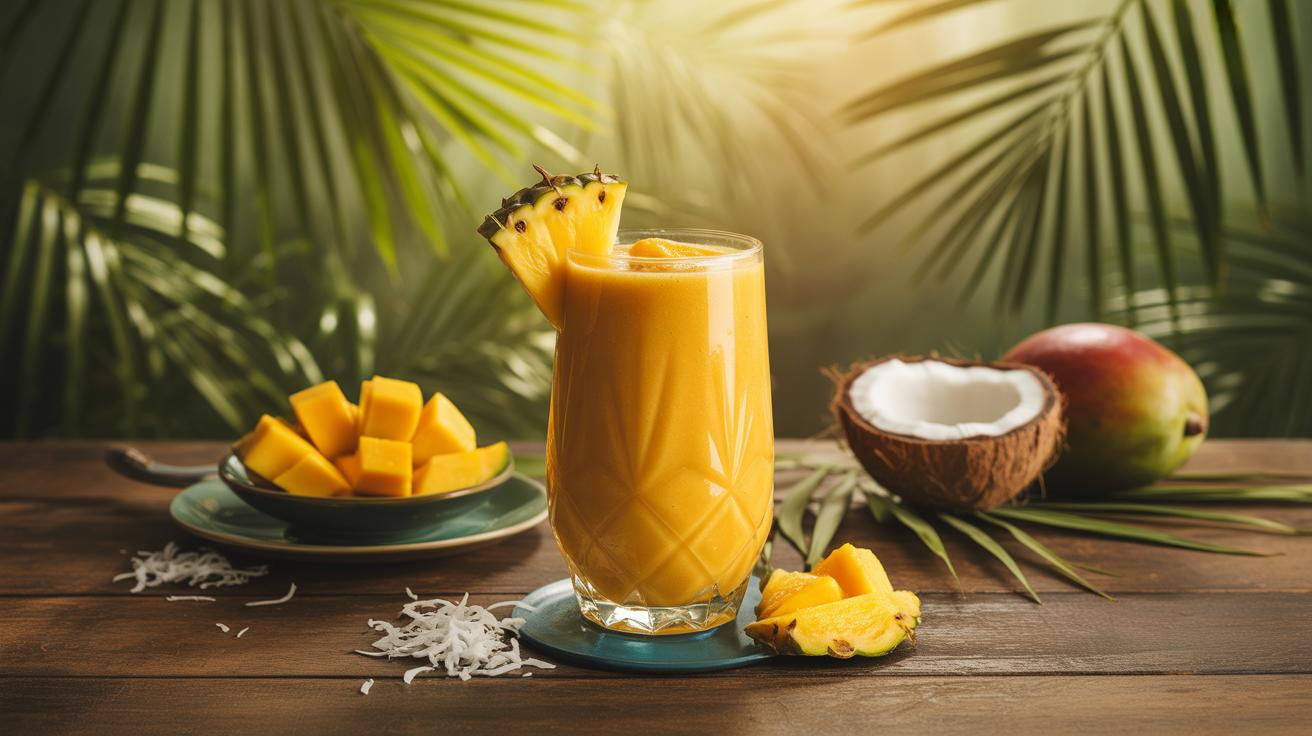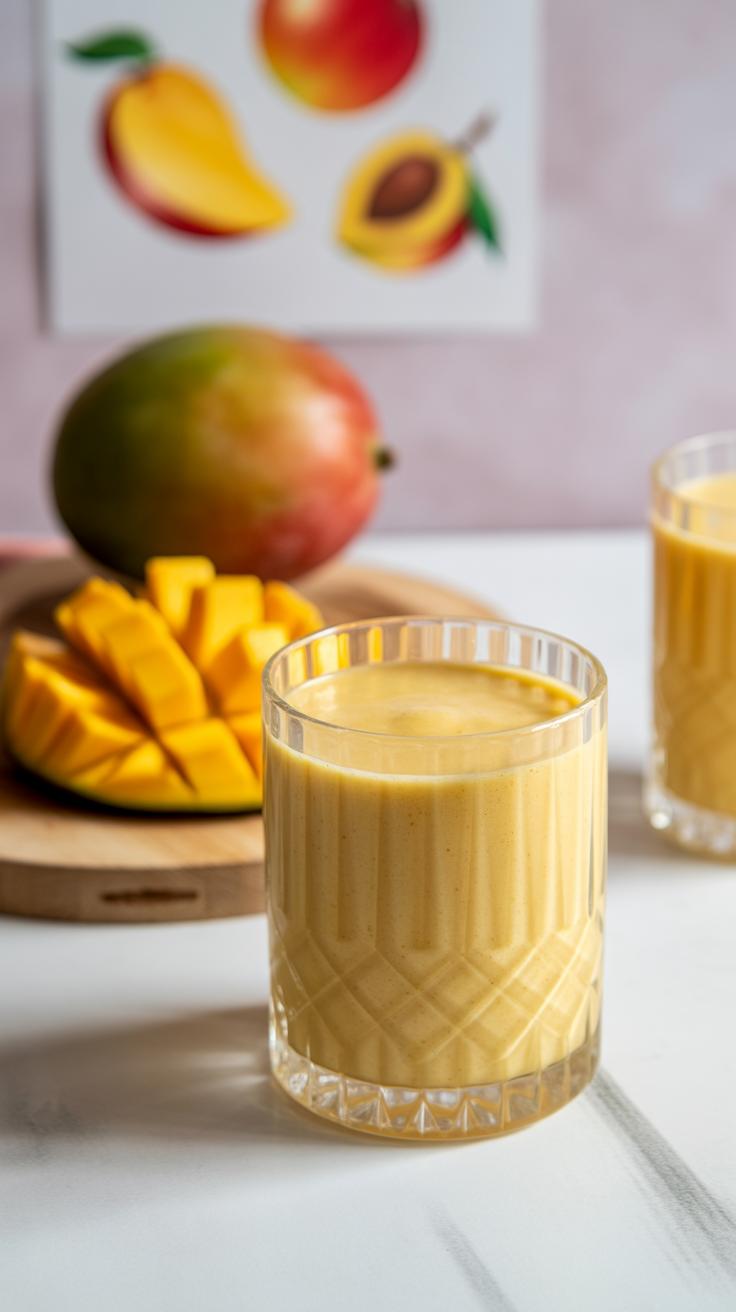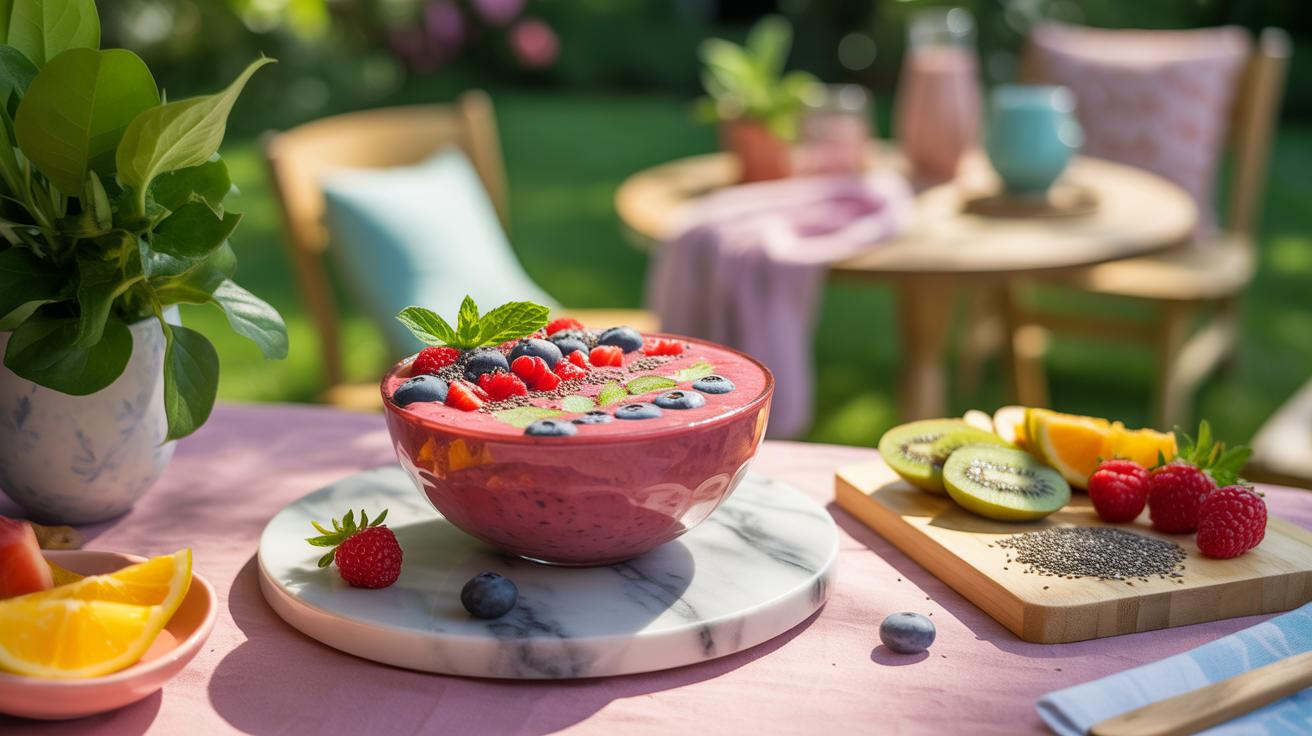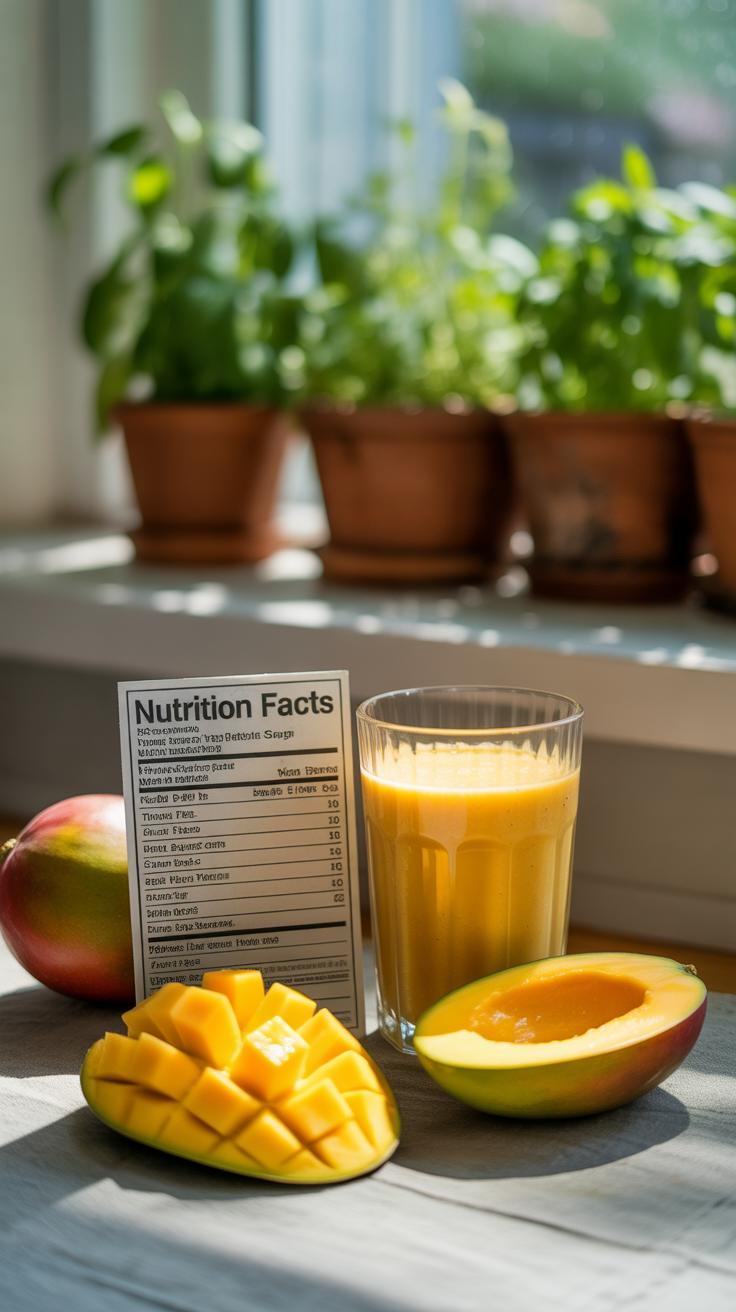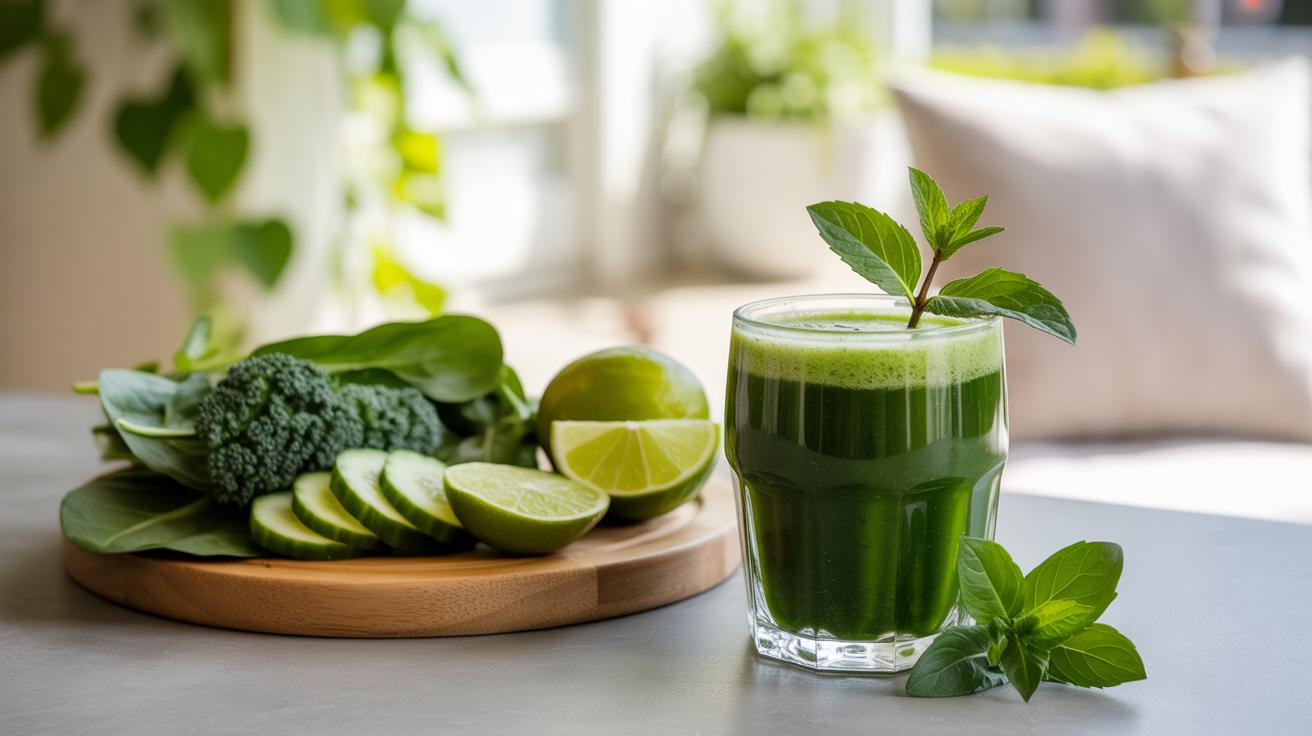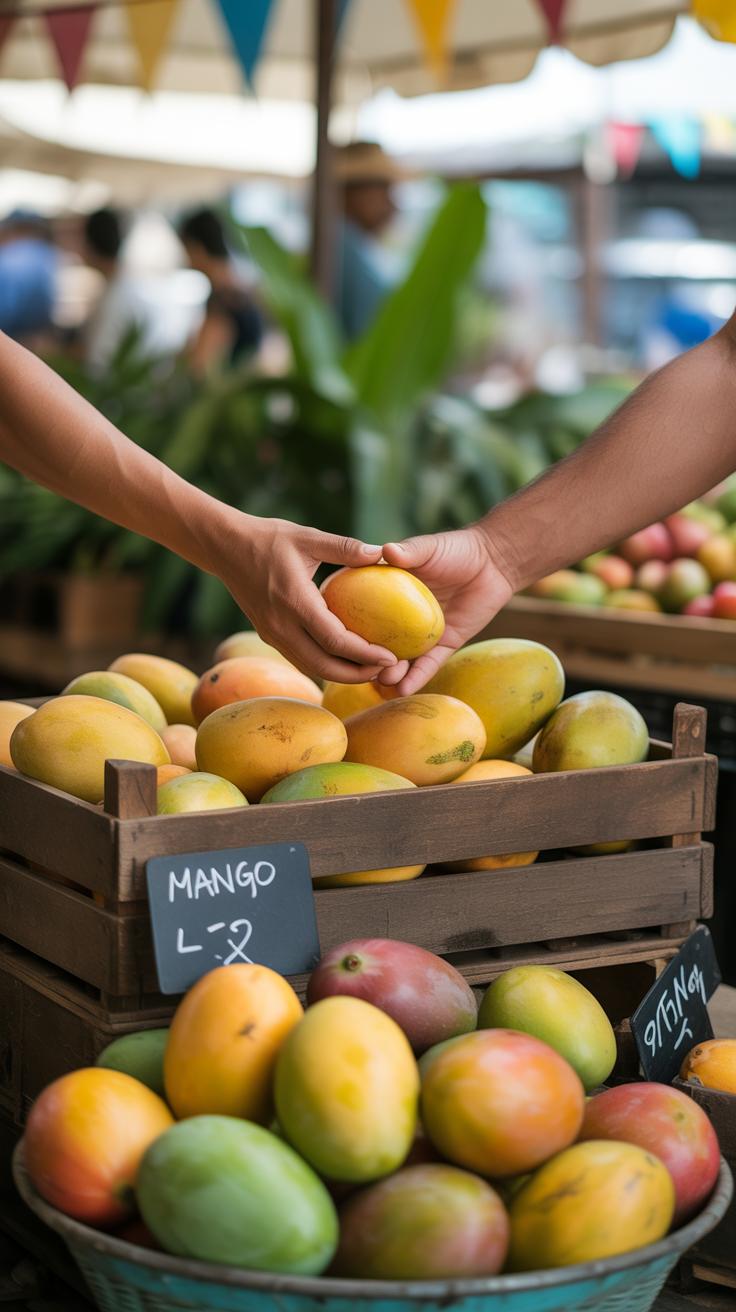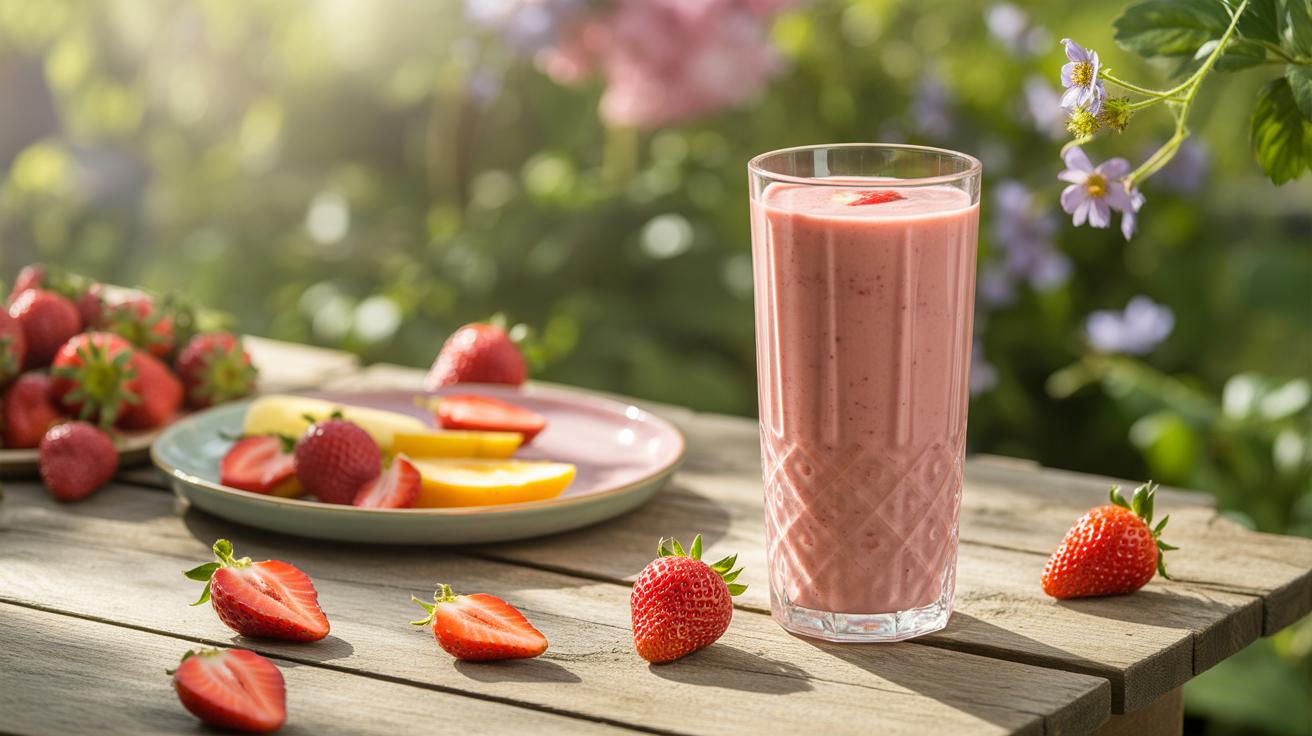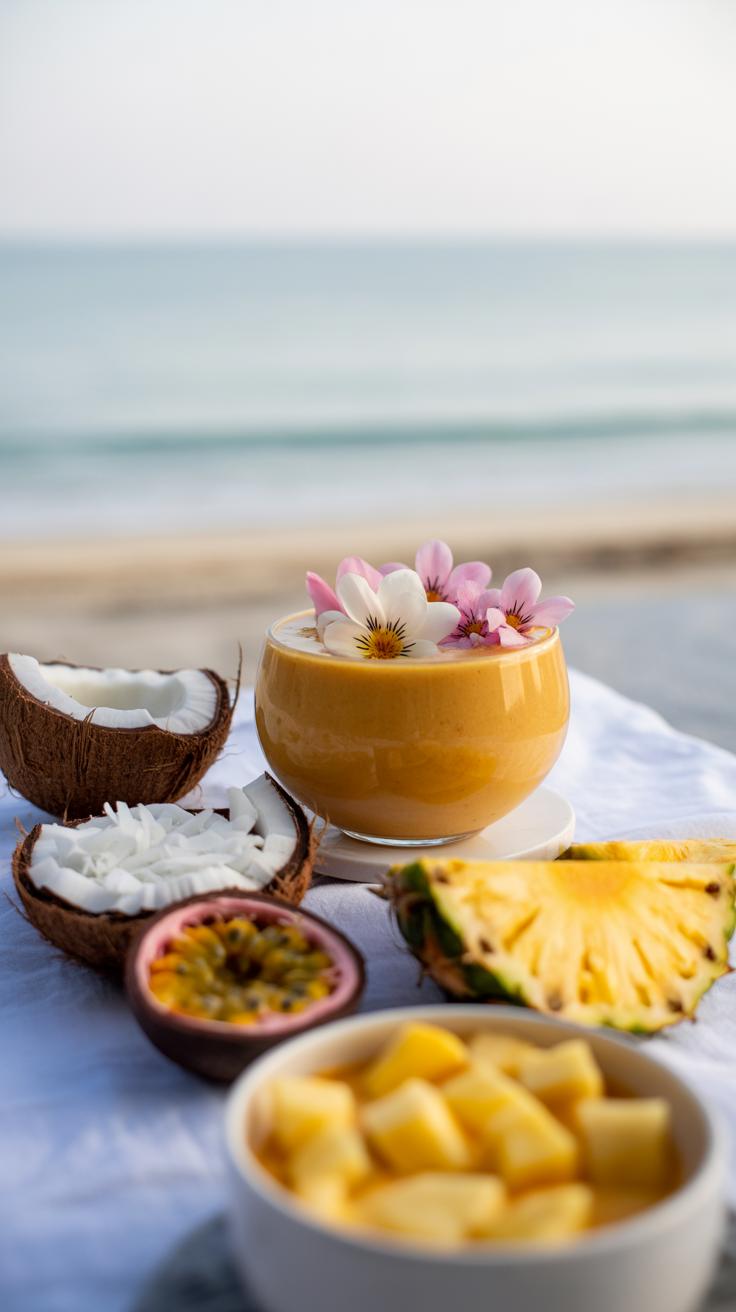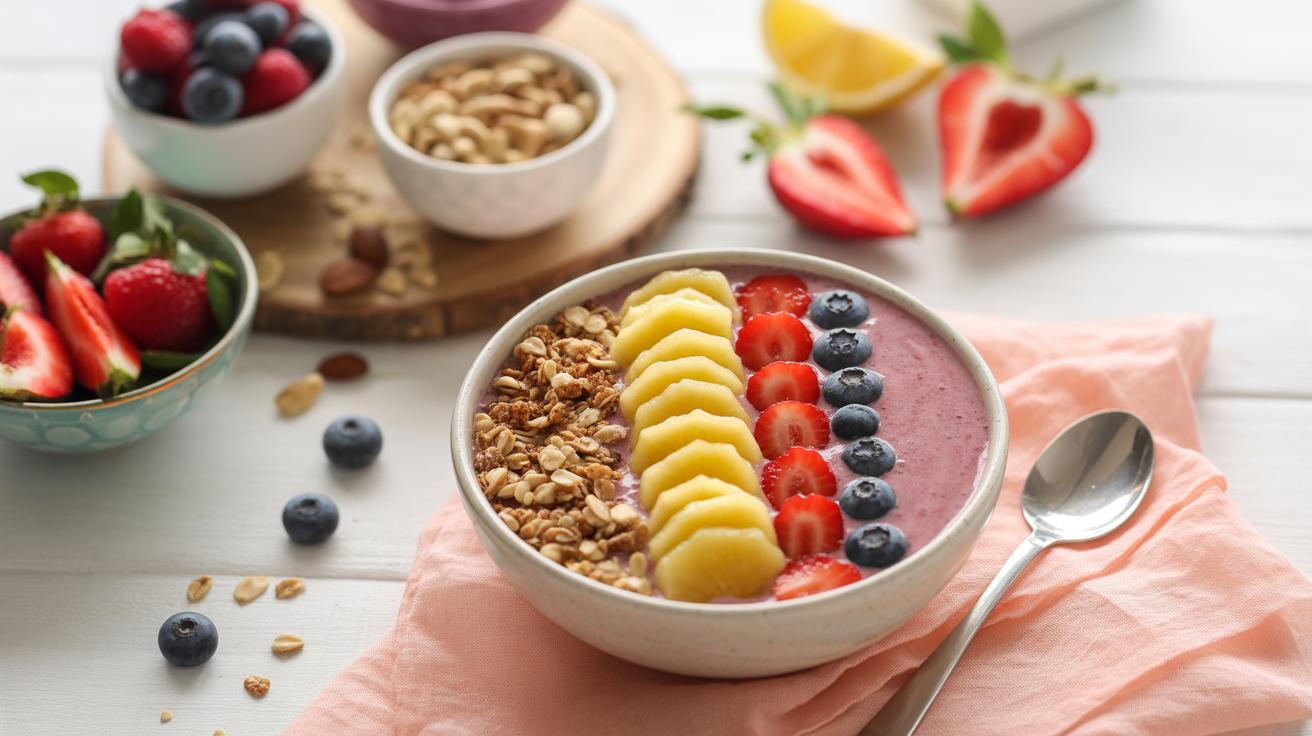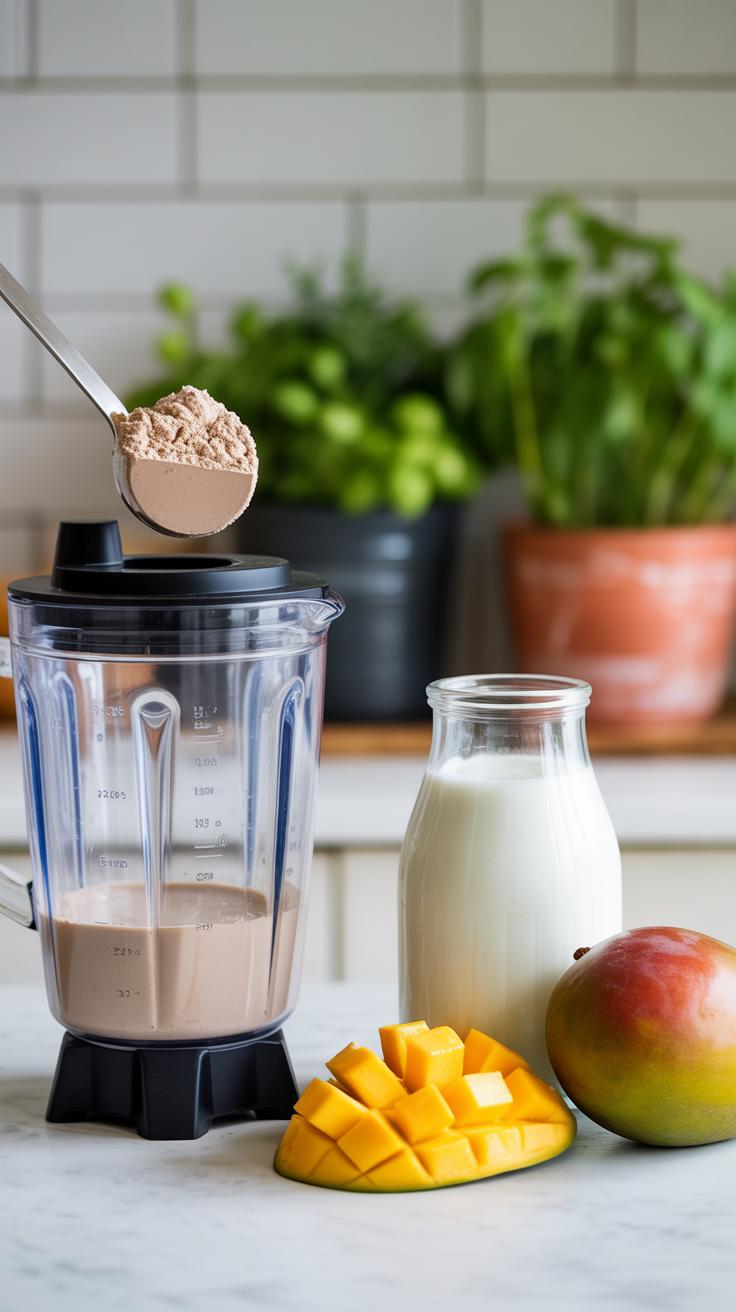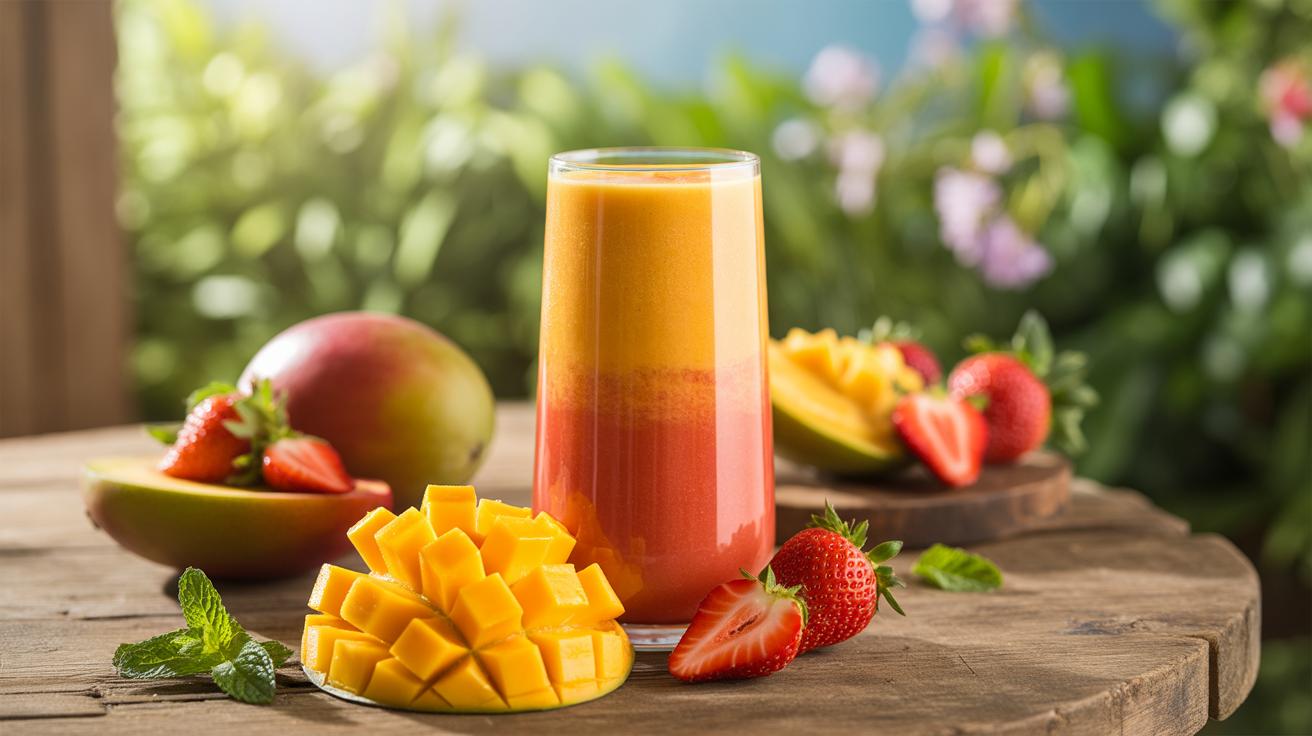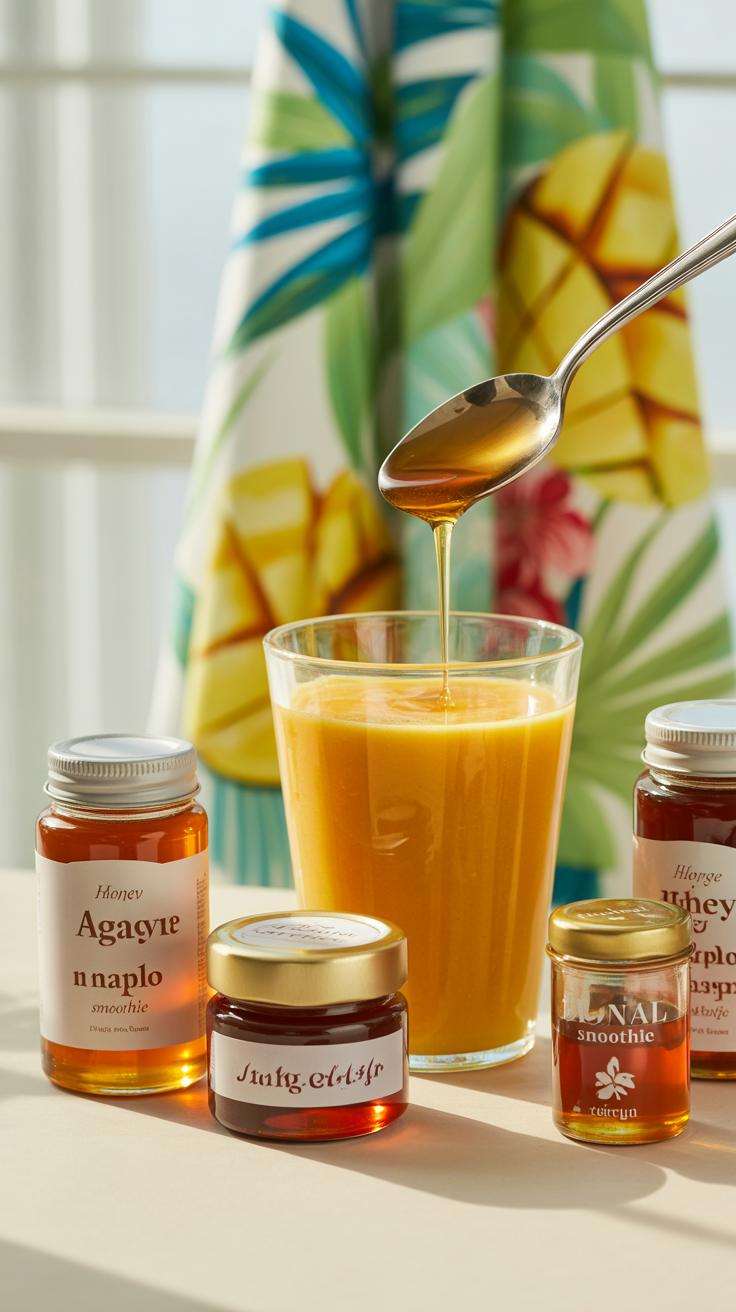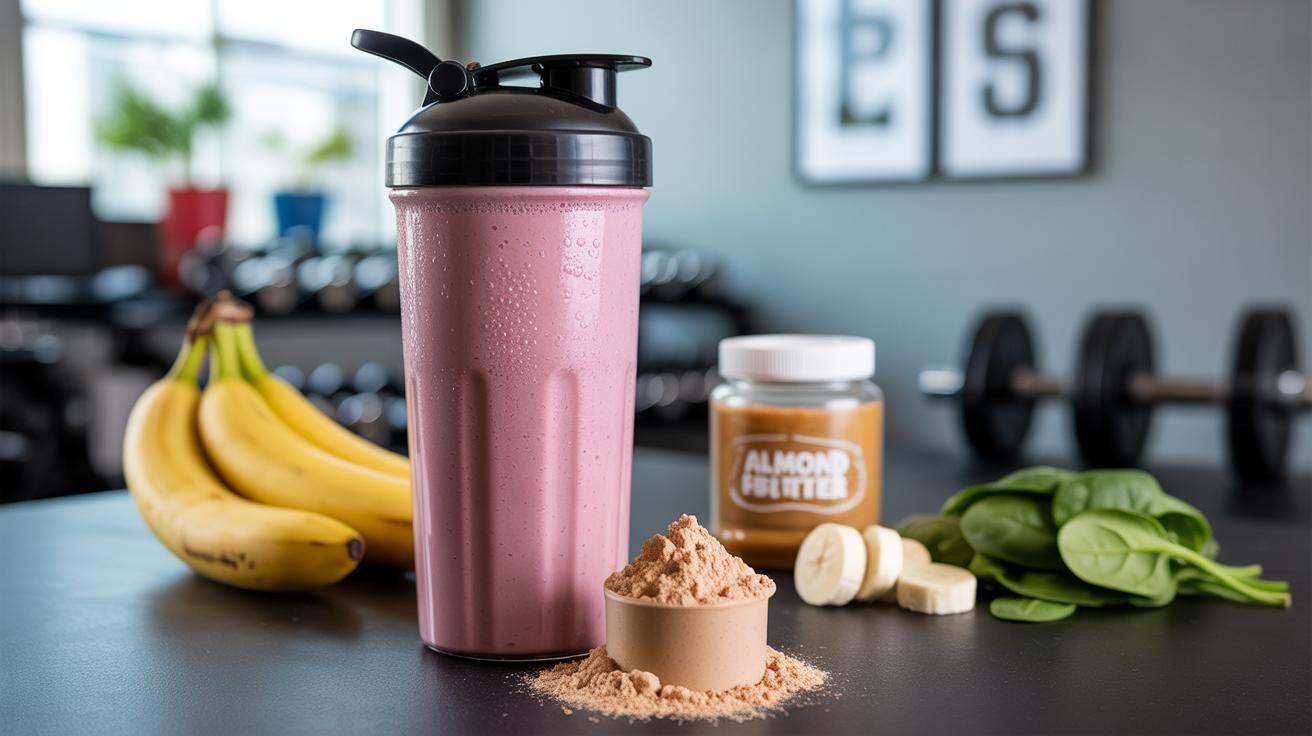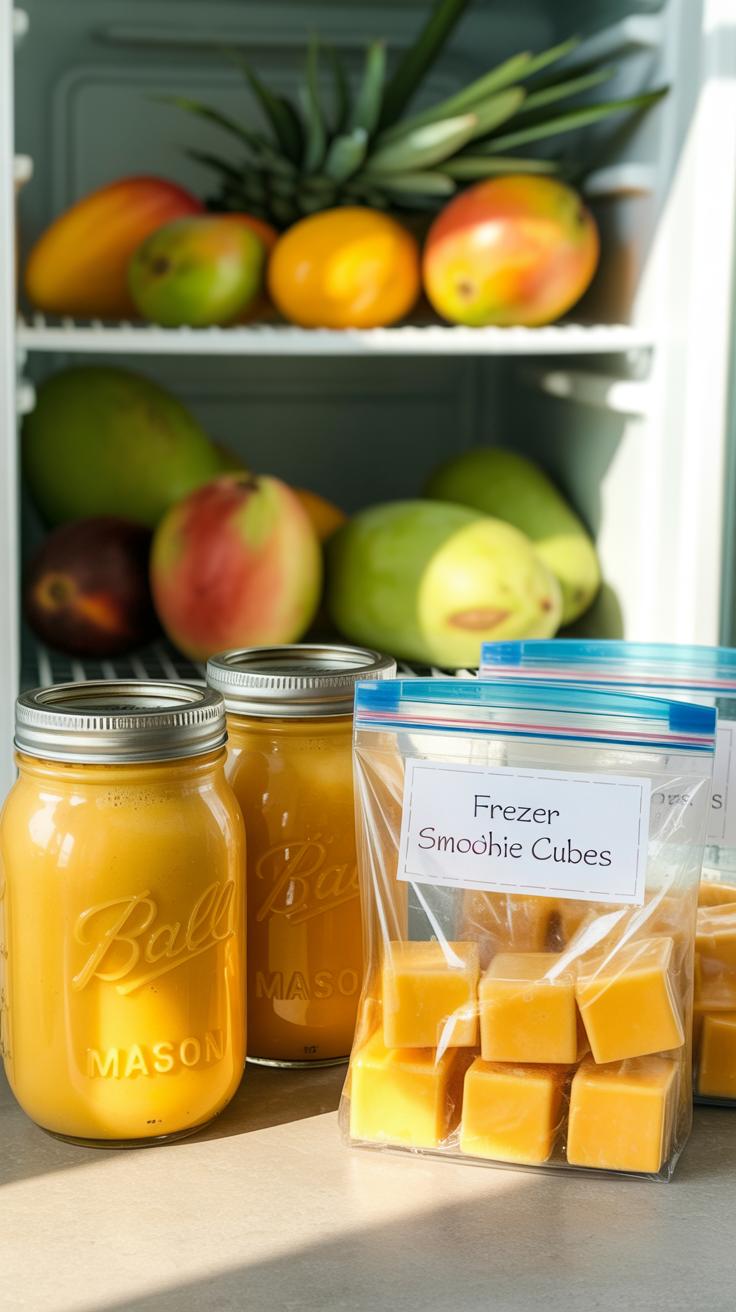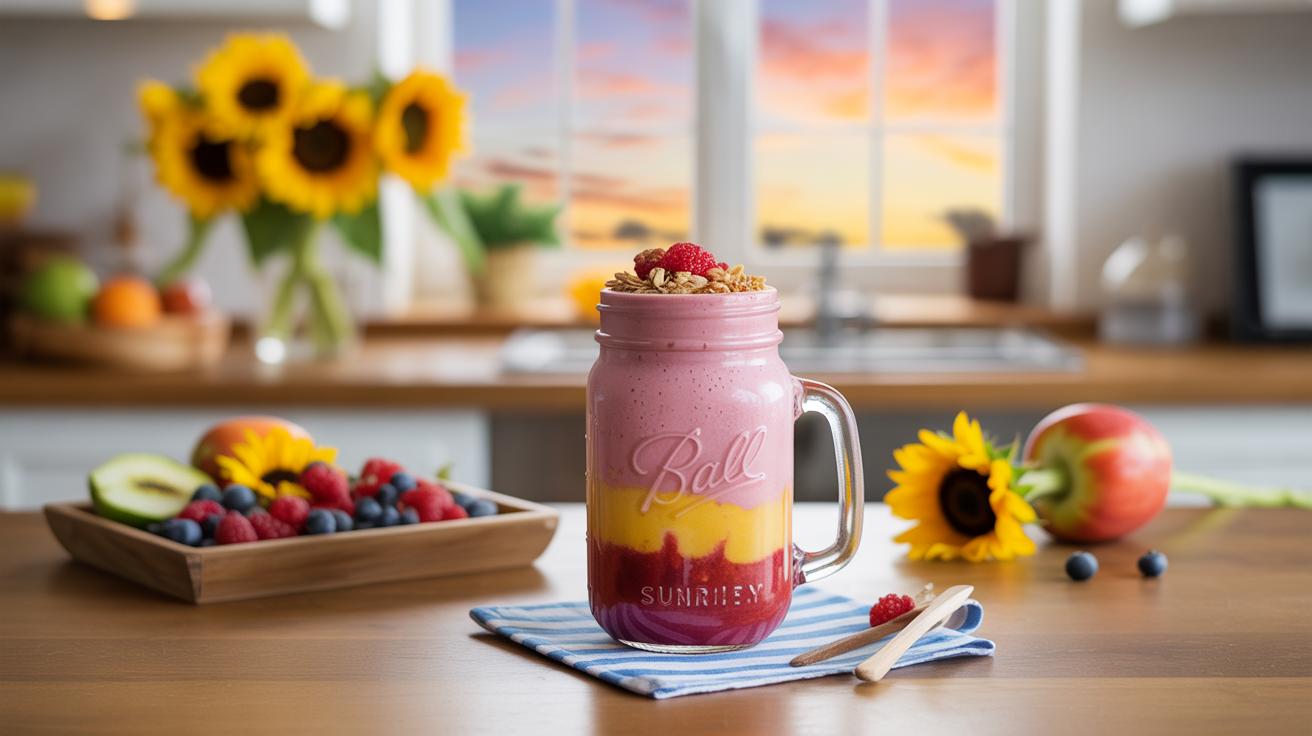Introduction
Mango smoothies offer a delicious and refreshing way to enjoy the nutritious benefits of mangoes, a tropical fruit treasured for its sweet and fragrant taste. By blending ripe mangoes with other tropical ingredients, you can create a rich and flavorful drink that not only tastes great but also provides essential nutrients.
This article explores the basics of mango smoothies, their health benefits, and how to elevate them by incorporating a variety of tropical flavors. You will learn practical tips to create your own delicious mango smoothie twist that can become a perfect treat for any time of the day.
What is a Mango Smoothie
A mango smoothie is basically a blended drink that highlights mango as the star ingredient. You take fresh or frozen mango chunks, toss them into a blender with a liquid base—often juice or milk—and whirl it all together until smooth. The goal? A creamy, thick pour that carries the mango’s sweet and sometimes slightly tart flavor throughout.
Choosing the right liquid matters. Some prefer orange juice, which adds a tangy zing and extra fruitiness, while others lean toward milk or plant-based alternatives like almond or coconut milk for a richer, smoother feel. You might also notice smoothies that include yogurt, which thickens the texture and lends a bit of tang. When blending mangoes, the texture transforms from fibrous chunks to a silky, almost velvety consistency. That’s where the magic lies—no gritty bits, just pure mango essence suspended in your chosen liquid.
Basic Ingredients of a Mango Smoothie
At its core, a mango smoothie keeps things simple:
- Mango: Fresh or frozen peeled mango pieces, providing natural sweetness and vibrant color.
- Liquid base: Juice or milk (dairy or plant-based) to loosen the blend and create that perfect pourable texture.
Then you have extras, depending on taste and texture preferences:
- Yogurt: For creaminess and a subtle tang; also some protein.
- Sweeteners: Honey, agave, or even a pinch of sugar, though ripe mangoes often cut down the need.
- Add-ins: A squeeze of lime, a hint of ginger, or spices like cinnamon can tweak the profile.
How to Prepare a Mango Smoothie
Making a mango smoothie is straightforward. Here’s one approach I often go back to:
- Start with about 1 to 1½ cups of chopped mango—fresh if you have time, frozen if you want a chillier drink.
- Add ½ to 1 cup of your chosen liquid—juice or milk. Adjust this based on how thick you want your smoothie.
- Optionally, spoon in ¼ to ½ cup of yogurt for thickness and richness.
- Sweeten lightly if the mangoes aren’t quite ripe—maybe a teaspoon of honey or sugar.
- Blend everything on high for 30 to 60 seconds or until you see no chunks, just smooth, creamy liquid.
- Taste it. Sometimes you want a little more liquid, sometimes a sharper twist—add lime juice or a sprinkle of spice if it feels right.
- Pour into your favorite glass and enjoy immediately for the best flavor and texture.
It’s a quick process, but the outcome can vary every time, which makes experimenting with different bases or add-ons part of the fun. Have you tried almond milk or coconut water in your mango smoothies? They change the experience more than you might expect.
Nutritional Value of Mangoes in Smoothies
Vitamins and Minerals in Mangoes
Mangoes come packed with a range of vitamins and minerals that might surprise you. For one, they’re a good source of vitamin C, which plays a crucial role in supporting your immune system and helping your body repair tissues. Then there’s vitamin A, mostly from beta-carotene, which benefits your eyes and skin. You’ll also find decent amounts of folate, important for cell function and growth, especially if you’re planning for pregnancy or just trying to stay healthy. Plus, minerals like potassium provide support in regulating blood pressure and fluid balance.
It’s interesting because these nutrients don’t just hang around on their own; they work together inside your body in ways that keep multiple systems humming. You might not notice it immediately, but over time these little benefits add up.
Health Benefits of Mango Smoothies
Drinking mango smoothies offers more than just a tasty treat. The fruit’s fiber content can help tidy up digestion—fiber encourages smooth bowel movements and may avoid uncomfortable bloating. Also, because smoothies often include liquid bases like water, milk, or juice, they naturally contribute to hydration, which is something many people overlook.
I remember once after a hot day, a mango smoothie was not only refreshing but left me feeling more balanced and less sluggish. There’s something about the natural sugars combined with vitamins that might give you a subtle energy lift, without the crash typical of processed snacks. You might ask if it’s enough for a health boost. Maybe it is, maybe it’s a little nudge, but it’s worth thinking about what you drink alongside your meals.
Plus, the antioxidants present in mangoes — including some lesser-known compounds — might support overall wellness by helping your body combat everyday stressors. While not a miracle, sipping a mango smoothie could be one piece of your daily health puzzle, no matter your routine.
Choosing the Best Mangoes for Your Smoothie
Picking the right mango for your smoothie can feel a bit tricky, but it makes a big difference in flavor and texture. When you look at a mango, what stands out first is the color. A ripe mango usually has warm hues of yellow, orange, or even a blush of red. Still, color alone doesn’t tell the whole story. Sometimes green mangoes can be ripe too, so you can’t just trust looks.
Press the mango gently. If it gives a little under your fingers, similar to a ripe peach, it might be ready to blend. Too soft? That could mean it’s overripe and might taste a bit fermented or mushy. Texture matters because you want your smoothie to be smooth, not stringy or gritty.
The smell is one of the best clues. A ripe mango often gives off a sweet, fragrant aroma near the stem end. If you don’t notice that scent, it may be underripe, even if the fruit feels soft.
As for varieties, some types work better in smoothies than others because of their sweetness and fiber content. Alphonso mangoes, for example, have a rich, creamy texture and intense flavor, perfect if you want a sweeter taste. Ataulfo mangoes, smaller and buttery, blend into a velvety base. Tommy Atkins is widely available, a bit fibrous but holds up well if you don’t mind a little chew. Kent mangoes are juicy and less fibrous, and Keitt mangoes stay green even when ripe — a detail that can confuse at first.
Now, the question might be: should you always choose the softest mango? Not necessarily. Some recipes might need a mango that’s just turning ripe, for a fresher, more tart note. It’s a matter of preference—and patience—for what flavor you want in your smoothie.
Incorporating Tropical Flavors
When you think of a mango smoothie, the mind often jumps straight to its sweet, juicy taste. But what if you add some other tropical fruits into the mix? Fruits like pineapple, coconut, and banana don’t just boost flavor—they also bring in new textures and nutrients that make the smoothie more interesting. Pineapple adds a tangy brightness that can cut through the sweetness of mango, while coconut contributes a creamy, mellow undertone that feels almost luxurious. Banana, on the other hand, provides natural sweetness and a silky thickness that rounds everything out.
It’s kind of fun to experiment here because these fruits are so versatile. Depending on what you pick, your smoothie can turn refreshing, rich, or even a bit tart. Plus, mixing these flavors can sneak in more vitamins and minerals without making it taste like you’re eating a salad.
Tropical Fruits to Pair With Mango
Here’s a shortlist of tropical fruits that pair nicely with mango, each bringing something a bit different to your blender:
- Pineapple: Tart and juicy, with a sharp sweetness.
- Coconut: Creamy, slightly nutty, adds smoothness.
- Banana: Sweet and soft, thickens smoothies naturally.
- Passion Fruit: Tangy, fragrant, a bit floral.
- Papaya: Mildly sweet, buttery texture.
- Guava: Sweet-tart, grainy pulp for texture.
- Kiwi: Bright, acidic, with a tiny crunch from seeds.
Each of these brings a unique twist, sometimes subtle, sometimes bold. I’ve often found myself surprised by how well these flavors interact.
Creating Flavor Combinations
Putting these fruits together is where the real fun begins. You can try mango with pineapple for a smoothie that feels like a mini tropical vacation. Or maybe mango and coconut paired with a splash of lime juice to make it a little tangy and creamy at once. Adding banana tends to soften sharper flavors, so mango, banana, and passion fruit create a sweet but vibrant blend that works as an afternoon pick-me-up.
Here are some combos you might want to try:
- Mango + Pineapple + Coconut Water
- Mango + Banana + Passion Fruit
- Mango + Papaya + Lime Zest
- Mango + Guava + Greek Yogurt (okay, a bit of dairy, but you’ll understand why in the next chapter!)
- Mango + Kiwi + Fresh Mint
You might wonder if some combinations are too sweet or clash. Sometimes they do, or sometimes you find yourself liking something unexpected. The takeaway? Don’t hesitate to tweak and test. After all, your perfect mango smoothie twist probably hasn’t been made yet.
Using Protein and Dairy in Mango Smoothies
When it comes to adding protein to your mango smoothie, there are quite a few choices, and each brings something different. Whey protein is a popular pick—not just for muscle recovery but because it blends smoothly without overpowering the mango’s flavor. Yet, some people prefer plant-based options like pea, rice, or hemp protein powders. These alternatives often add a bit of earthiness, which can either complement or clash, depending on your taste buds and the other ingredients.
Yogurt is another excellent source of protein and creaminess. Greek yogurt, thicker and tangier, gives body to the smoothie and balances the sweetness of ripe mango. On the other hand, regular or flavored yogurt can shift the flavor more noticeably, sometimes unexpectedly. If you’re dairy sensitive, plant-based yogurts made from almond, coconut, or soy can offer similar texture with subtle differences in taste and nutrition.
Adding dairy or its alternatives affects both the feel and the nutrition of your smoothie significantly. Dairy lends a creamy texture, helps thicken the drink, and offers calcium and vitamin D. It’s not just about texture; the fats in full-fat dairy also carry flavor better, making the smoothie richer. Yet, this can be a double-edged sword if you want a lighter, more refreshing taste—it may feel a little heavy for some people.
Have you ever noticed how a tiny tweak in the dairy or protein you use can change the whole experience of your mango smoothie? Sometimes, less really is more. Playing around with these options can help you find a balance that satisfies your hunger and your palate without overwhelming that subtle mango essence.
Sweeteners and Enhancers for Smoothies
When you’re working with mangoes, sweetness is already a given. But sometimes, you want just a touch more without drowning out that fresh fruit flavor. Natural sweeteners can do this well. Think of honey—a little drizzle can raise the sweetness gently. It’s not too sharp, just warm and mellow. Agave nectar also fits nicely; it’s milder and dissolves easily, blending with cold smoothies without leaving a sticky feeling.
Dates are an interesting option, though. If you soak and blend them first, they add a rich, caramel-like undertone. But, be careful—dates can shift the smoothie’s texture slightly, making it thicker than you might expect.
Natural Sweeteners to Use
- Honey – adds smooth sweetness without being too intense
- Agave nectar – subtle, dissolves quickly and keeps the drink light
- Dates – natural caramel hints, but may thicken your smoothie
Spices and fresh herbs can also lift your mango smoothie. A small piece of fresh ginger introduces a gentle bite, an almost spicy warmth that balances the fruit’s sweetness. Mint leaves add an unexpected coolness. They don’t scream for attention but quietly brighten every sip.
These enhancers don’t mask mango’s essence. They frame it, add complexity. You might find yourself pausing after a gulp, curious about that faint zing or cooling note. It’s subtle—perhaps even confusing at first—but a subtle twist can make all the difference.
Flavor Enhancers and Spices
- Fresh ginger – offers a spicy contrast that excites your palate
- Mint leaves – inject light, refreshing undertones
Have you tried mixing these with your mango smoothie before? Sometimes, less really is more. A tiny bit of ginger or a leaf or two of mint can do enough. Should you go heavier, the sharpness might take over, and that’s not what you want when you’re savoring mango’s natural charm.
Tips for Serving and Storing Mango Smoothies
Best Serving Suggestions
Serving your mango smoothie at the right temperature can make a surprising difference. I often find that chilling it just enough—not too cold—helps bring out the mango’s natural sweetness without numbing the flavors. Try serving it slightly cool rather than ice-cold straight from the blender; the texture feels smoother that way.
When it comes to garnishes, simple touches work best. A small wedge of fresh mango or a sprinkle of toasted coconut on top adds texture and a hint of tropical aroma. Mint leaves can add a fresh contrast, but be careful—they can overpower that subtle mango essence if used too liberally.
You might experiment with a light dusting of chili powder or grated lime zest for a little unexpected kick. It’s not for everyone, but occasionally, the contrast enhances the drink more than you’d expect. Give it a whirl if you’re feeling adventurous.
Storage and Shelf Life
Fresh mango smoothies don’t keep long. I usually recommend consuming them within 24 hours for the best taste and texture. After that, the flavors start to dull, and the smoothie can separate.
If you have leftovers, store them in an airtight container in the fridge. Stir gently before drinking to bring the texture back together. Freezing might seem like a good idea, but it often changes the consistency—making it grainy or watery once thawed.
Occasionally, if you can’t finish it all, freezing in ice cube trays can be handy for adding back to your next smoothie batch without wasting anything. Though, it’s best not to hold on to those cubes for more than a week.
Mango Smoothie Variations Around the World
Mango smoothies might seem straightforward at first glance—just mango, some liquid, and maybe a touch of sweetener. But when you look closer, you find many cultures add their own spin, often with ingredients you wouldn’t expect. It’s kind of fascinating how a simple fruit leads to such diverse blends.
Popular Mango Smoothie Styles
Take India, for example. The classic aamras-inspired smoothie usually includes ripe mangoes blended with yogurt. Sometimes a pinch of cardamom sneaks in, adding a warm aroma that changes everything. It’s thicker, creamier, and has this subtle spice note that feels like comfort.
In Southeast Asia, particularly Thailand and the Philippines, mango smoothies often come with coconut milk. The richness of coconut softens the mango’s sharp sweetness, and occasionally, a squeeze of lime slices through the blend, giving it a little lift. It’s refreshing but not overly sweet.
Over in the Caribbean, mango smoothies sometimes transform into a drink called “mangú,” where mango meets rum or spices like ginger and nutmeg. It’s a bit unexpected but intriguing if you’re up for a smoothie that leans more into dessert territory.
Cultural Ingredients and Techniques
What really sets these smoothies apart isn’t just the ingredients but how they’re prepared. In India, the mango pulp is often hand-scooped from perfectly ripened fruit, then mixed gently with chilled yogurt, sometimes left to rest so flavors meld quietly.
Southeast Asian versions might involve more rapid blending with crushed ice and a splash of coconut cream, aiming for a cold, slushy texture. Some places even add tapioca pearls or sweet corn kernels—odd, but it works in context.
Meanwhile, Caribbean recipes favor blending ripe mango with bold spices and occasionally incorporating fresh-squeezed citrus juice. They might shake things up with a hand-held blender or just stir vigorously by hand—techniques that impact the final feel of the drink.
So, when you sip a mango smoothie from one region or another, you’re tasting their culture in small, surprising ways. Have you tried them side by side? Which one felt most natural or maybe the most curious?
Creating Your Own Mango Smoothie Recipes
When it comes to crafting your own mango smoothie, don’t be shy about mixing things up. Maybe you like it tangy, or perhaps you prefer it creamy. There’s no strict formula, and that’s part of the fun. Start by pairing mango with other tropical fruits like pineapple, papaya, or passion fruit—these add layers of flavor without overpowering the mango’s natural sweetness.
Think about texture too. Adding something like coconut milk or Greek yogurt can give you that silky mouthfeel, while chia seeds or oats introduce a bit of substance. But be careful. Too many thick elements can weigh the smoothie down. It’s a balance that sometimes takes a few tries to get right.
When experimenting, try this loose approach:
- Use ripe mangoes as your base—they bring that rich flavor you want.
- Add a splash of citrus juice or zest for brightness.
- Sweeten lightly; sometimes mango alone is enough, but a touch of honey or agave can help if your fruit is underripe.
- Consider nutrient boosts like spinach or protein powder, but introduce them gradually.
Nutrition matters, yes, but don’t let it kill the joy of taste. Sometimes, a bit more sweetness or creaminess wins over the healthiest mix. The trick is to find what feels both satisfying and nourishing to you. Don’t hesitate to adjust ingredient ratios as you go—they’ll change with the fruits’ ripeness, your mood, and even the season.
What flavors are you curious to try next? Maybe a hint of ginger or fresh mint? Your kitchen is your lab, so let your taste buds lead.
Conclusions
Refreshing mango smoothies are more than just a tasty beverage; they combine the health benefits of mangoes with the diverse flavors from tropical fruits. These smoothies offer hydration, essential vitamins, and a delightful taste experience that is easy to prepare at home.
By experimenting with different tropical ingredients, you can customize your mango smoothie to suit your preferences. Whether for breakfast, a snack, or a post-workout refreshment, this vibrant drink brings energy and enjoyment with every sip, encouraging you to maintain a healthy and flavorful lifestyle.

